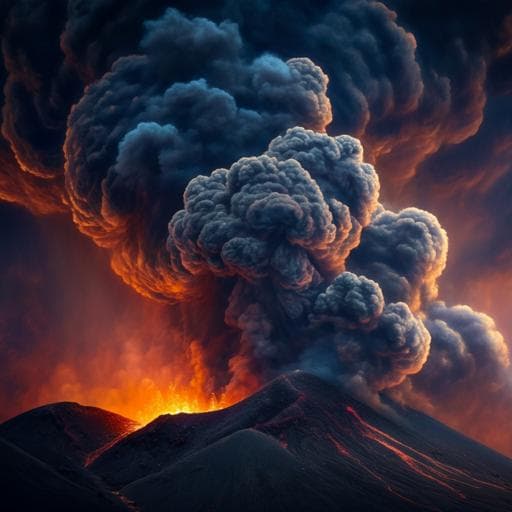
Earth Sciences
Global perturbation of stratospheric water and aerosol burden by Hunga eruption
S. Khaykin, A. Podglajen, et al.
The January 2022 Hunga Tonga volcano eruption marked a historic climatic event, injecting material 58 km into the atmosphere, increasing global stratospheric water mass by 13%, and massively amplifying aerosol load. Discover the insights from this groundbreaking research conducted by Sergey Khaykin and colleagues.
~3 min • Beginner • English
Introduction
The main eruption of the Hunga submarine volcano (Tonga) on 15 January 2022 was likely the most explosive event of the modern observational era, with a VEI of ~5.8. The blast produced a plume reaching ~58 km, directly injecting volcanic gases and vaporized seawater, along with entrained tropospheric moisture, into the stratosphere. Stratospheric dryness is typically set by freeze-drying at the cold tropical tropopause, limiting water entry to a few ppmv. Because the atmospheric radiation budget is sensitive to water vapor changes in the upper troposphere and lower stratosphere, even small increases can cause significant radiative forcing and alter ozone chemistry. Model projections suggest that increased stratospheric water with warming could generate positive climate feedbacks and modify atmospheric circulation (e.g., strengthening Brewer–Dobson circulation). Historically, it has been proposed that major eruptions could hydrate the stratosphere due to large volcanic water emissions and entrainment, but robust observational evidence was lacking. Early analyses of the January 2022 Hunga event provided the first observations of substantial volcano-driven stratospheric hydration, plausibly enhanced by the submarine eruption. Without efficient sinks for moisture in the stratosphere, such hydration could persist for years, affecting ozone, radiation, and dynamics. Another key question is the global impact on stratospheric aerosol loading. This study aims to describe and quantify the stratospheric repercussions of the Hunga eruption, investigating the formation and evolution of the stratospheric moisture and sulfate aerosol plume across scales using synergistic satellite and ground-based observations and transport modeling, to assess its climate-altering capacity over annual scales.
Literature Review
Prior work has established the mechanisms controlling stratospheric water and its climatic effects, including the role of the cold-point tropopause in setting stratospheric humidity, the sensitivity of radiative forcing to stratospheric water changes, impacts on ozone chemistry, and circulation responses to altered stratospheric water. Historical analyses suggested that large eruptions (e.g., Tambora, Krakatoa) could hydrate the stratosphere due to water-rich volcanic gases and entrained moisture, though previous estimates (e.g., Pinatubo ~37 Tg H2O) were model-based. Modeling studies anticipated potential ice persistence and hydration at high altitudes following eruptions. Early studies specific to Hunga (in 2022) reported substantial stratospheric hydration and highlighted possible rapid SO2 conversion to sulfate in a water-rich plume. Observations of prior major eruptions (El Chichón 1982, Pinatubo 1991) and more recent sulfate and smoke events (Sarychev 2009, Calbuco 2015, Raikoke 2019, Australian wildfires 2019/2020) provide context for plume transport timescales, aerosol growth, and radiative impacts. The present study builds on these findings by integrating multi-sensor observations and modeling to quantify the unprecedented magnitude and structure of Hunga-induced perturbations.
Methodology
The study integrates multiple satellite, ground-based, in situ, and modeling datasets over ~9 months post-eruption. Key components include:
- Stereoscopic cloud top height retrieval from GOES-17 ABI and Himawari-8 AHI 10.3 μm IR imagery: chip-based cross-correlation stereoscopy yields cloud-top heights with ~0.2–0.4 km accuracy and ~4–6 km spatial resolution, documenting plume evolution on 15 January 2022.
- COSMIC-2 GNSS radio occultation: retrieval of stratospheric water vapor from refractivity anomalies assuming environmental temperature and pressure from ECMWF. Extreme plume anomalies were converted to water vapor mixing ratios, with uncertainty estimated from pre-eruption profiles. Early injected water mass was inferred by integrating profiles (20–50 km) and multiplying by the observed plume area (~150,000 km²), giving 75–140 Tg (vapor only), acknowledging uncertainties and neglect of remaining ice.
- Aura MLS: primary use of v5.01 H2O and geopotential height products for climatology and mass calculations (100–1 hPa), with v4.32 for early evolution due to v5 pointing issues in extreme humidity. Quality flags were relaxed for early plume detection consistent with prior studies. Stratospheric H2O mass burden was derived from MLS VMR with air density from MLS temperature; uncertainties combine measurement accuracy and variability.
- OMPS-LP: V2.0 aerosol extinction at 675 nm for long-term SAOD analysis; V2.1 (extended to 45 km) for early plume and vertical structure, including extinction ratio (aerosol/molecular). Tomographic retrievals at 755 nm with 1–2 km vertical resolution were used to estimate sedimentation by tracking peak plume altitude.
- CALIPSO CALIOP: 532 nm total attenuated backscatter and depolarization ratio to identify particle type (spherical sulfate vs non-spherical ash/ice) and detect upper-level aerosol layers (up to ~37 km where measurable).
- SCISAT ACE-FTS: Version 4.1/4.2 Level 2 H2O and HDO profiles from solar occultation to derive δD (HDO/H2O relative to SMOW) and diagnose the water source, focusing on 12–40 km.
- ISS SAGE III/ISS: Version 5.2 multi-wavelength aerosol extinction used to retrieve particle effective radius from lognormal fits, assuming standard H2SO4/H2O composition (and a pure-water sensitivity case) to bracket refractive index uncertainty.
- Aeolus ALADIN: L2A aerosol/cloud optical product (HSRL at 355 nm) to corroborate aerosol layer dispersion and subsidence.
- Radiosoundings: Vaisala RS41 sondes in Southern tropics (Australia, Saint Helena, Seychelles, Chile, Argentina) documented elevated stratospheric humidity layers (20–30 km). Contamination by outgassing was mitigated by focusing on early ultra-moist plume passes and using anomaly approaches for later detections.
- Ground-based lidars: 532 nm aerosol backscatter from stations spanning 67° S–69° N used to time and trace meridional dispersion; plume detections defined by scattering ratio >1.2.
- GloSSAC v2.1: 525 nm stratospheric aerosol climatology (1979–2018) extended with OMPS-LP and SAGE III to place SAOD anomalies in historical context.
- CLaMS (Chemical Lagrangian Model of the Stratosphere): Lagrangian chemistry-transport simulations driven by ECMWF analyses, with water vapor initializations from MLS (pre- and post-eruption), diabatic vertical coordinate and clear-sky heating rates. Simulations captured plume morphology, transport (zonal/meridional), and provided comparisons to MLS detections.
Analytical approaches included constructing zonal and time-latitude anomaly fields (relative to MLS climatology), tracking plume centroid altitude and circumglobal progression across altitude bands, estimating vertical motion (subsidence/ascent), quantifying global and hemispheric stratospheric water mass anomalies (MLS), estimating aerosol sedimentation rates (OMPS-LP tomographic peaks and CALIOP corroboration), and compiling SAOD anomalies relative to a volcanically quiet baseline (1995–2003).
Key Findings
- Injection altitude and immediate plume structure: The eruption plume reached ~58 km within minutes; MLS observed a ~12 km-thick enhanced H2O layer topping ~52 km on 15 Jan. CALIOP detected strongly depolarizing particles at 35–40 km just beneath the moist plume. COSMIC-2 soundings showed extreme stratospheric H2O anomalies up to ~14,000 ppmv near 33 km, indicating near-saturation and humidity more than three orders of magnitude above background.
- Injected water mass and global burden: The eruption increased the global stratospheric water mass (100–1 hPa) by 119 ± 6 Tg, i.e., about 13–16% over climatology (Southern Hemisphere ~24%, Northern Hemisphere ~11%). GNSS-RO-based early estimates gave 75–140 Tg vapor within the young plume area. The perturbation is about five times larger than the 2019/2020 Australian wildfire-induced record (~27 Tg) and unprecedented in the satellite era (since 1985).
- Aerosol loading: Stratospheric aerosol optical depth (SAOD) increased 4–5-fold over background, the largest in the last three decades, though the absolute SAOD remained at least six times smaller than Pinatubo and three times smaller than El Chichón. Early lidar at La Réunion observed an AOD ~0.6 and scattering ratio up to ~280 at 532 nm around 27–30 km—among the most intense stratospheric aerosol plumes observed by ground-based lidars.
- Rapid global transport: The upper stratospheric moist plume (~45–50 km) circumnavigated the Earth in ~1 week and completed three circuits in 25 days while ascending ~200 m/day. Aerosols above 40 km circled once in ~9 days. In the 30–40 km layer, moisture and aerosol plumes traveled in tandem and circled in ~9 days, covering the southern tropics in ~2 weeks. In 20–30 km, the bulk plume circled in ~2 weeks and subsided by ~200 m/day during the first circuit.
- Meridional dispersion: Within ~3–5 months the plumes spread from ~65° S to ~35° N, with faster transport to the Southern high latitudes in the lowermost stratosphere (3–4 weeks) and slower transport along the Brewer–Dobson branches (1–4 months) into both hemispheres. Ground-based lidars confirmed timings at multiple latitudes.
- Particle growth and sedimentation: SAGE III/ISS retrieved effective radii increased from background (~230 nm) to >400–500 nm (and up to ~500–700 nm per independent analyses) primarily in 22–26 km by mid-March, then began settling. OMPS-LP tomography indicated plume peak settling at ~0.26 mm/s; inferred radii of ~350–540 nm (April–May) matched SAGE III estimates, consistent with rapid SO2 conversion to sulfate droplets in a water-rich environment.
- Isotopic evidence for seawater source: ACE-FTS showed a strong enhancement in δD (HDO/H2O) within 23–29 km between 30° S–10° N, with values approaching SMOW signatures, indicating evaporated seawater as the primary moisture source. Such a large isotopic shift was not observed during the 2019/2020 wildfires.
- Aerosol vertical reach and character: Aerosols were detected up to ~37 km (CALIOP) during early days; depolarization suggested mostly spherical particles (sulfate droplets) since day +1. The Hunga plume’s maximum lidar scattering occurred much earlier than El Chichón, supporting expedited SO2 oxidation due to abundant water and possible heterogeneous processes.
- Longevity projections: SAOD anomaly peaked by early June 2022 and was projected to decay back to pre-eruption levels in ~14–17 months (by mid-2023). The stratospheric water anomaly decreased only ~2.5% over 9 months (~4.3% yr−1), implying persistence over >3 years.
Discussion
The findings demonstrate that the submarine Hunga eruption produced an unprecedented stratospheric hydration and a very large, rapid enhancement in stratospheric aerosols, fundamentally distinct from recent volcanic and wildfire events. The exceptional injection height enabled ultra-rapid circumglobal transport and broad meridional dispersion, while the water-rich environment accelerated SO2-to-sulfate conversion and particle growth, enhancing initial optical depths and expediting sedimentation thereafter. The massive 13% perturbation to global stratospheric water is unique in the satellite record and, due to the lack of efficient stratospheric moisture sinks, is expected to persist for several years. This persistent moistening likely modulates radiative balance, impacts stratospheric temperatures and dynamics (including Brewer–Dobson circulation), and could increase the frequency or extent of polar stratospheric clouds and related ozone depletion, with stronger effects in the Southern Hemisphere where the bulk of injected material resided months after the eruption. Although the aerosol perturbation decays relatively quickly (months), the enduring water vapor anomaly provides a rare natural experiment to evaluate climate sensitivity to large stratospheric composition changes. The integration of multi-instrument observations and modeling provides consistent characterization of plume evolution, transport, and microphysical changes, with implications for interpreting radiative forcing and circulation responses. Continued satellite observations (e.g., MLS-like capabilities) are critical to assess longer-term chemical and climatic impacts.
Conclusion
This study provides the first comprehensive, multi-sensor quantification of the Hunga eruption’s global stratospheric impacts, documenting: (i) an unprecedented 13% increase in global stratospheric water mass (~119 ± 6 Tg), (ii) a 4–5-fold increase in stratospheric aerosol optical depth (largest in three decades), (iii) ultra-rapid circumglobal transport and poleward dispersion, and (iv) rapid sulfate particle growth and settling in a water-rich environment. Isotopic measurements confirm seawater as the main moisture source. The aerosol perturbation is projected to relax to background within ~1–1.5 years, whereas the stratospheric hydration is expected to persist for several years, with potential implications for radiative balance, dynamics, and ozone. Future work should: sustain global limb-sounding of H2O, temperature, and aerosols to track decay and feedbacks; refine coupled chemistry–climate models to capture radiative-dynamical responses to large hydration; investigate microphysical pathways of rapid SO2 conversion and particle growth in humid stratospheric conditions; and assess regional and seasonal impacts, particularly in the Southern Hemisphere.
Limitations
- Early MLS v5 retrievals near extreme humidities suffer from pointing issues (up to ~2.5 km biases); v4 data were used for early plume analyses and some detections without strict quality filtering.
- GNSS-RO water retrievals rely on ECMWF temperature/pressure and assume refractivity anomalies are due solely to water vapor; uncertainties can yield unphysical values, mitigated by capping/saturation and using pre-eruption variability for error bounds.
- Vertical resolution limits of MLS complicate detection of thin layers; some aspects of deep Brewer–Dobson transport are not fully captured.
- Model–observation discrepancies (CLaMS vs MLS/OMPS) may arise from uncertainties in heating rates (affected by radiative cooling from excess moisture) and ECMWF meridional wind errors in the tropics.
- CALIOP depolarization is unavailable above ~40 km, limiting the characterization of upper-stratospheric aerosol type.
- SAGE III particle size retrievals depend on assumed aerosol composition and refractive index; pure-water vs H2SO4/H2O assumptions bracket but do not eliminate uncertainty.
- Radiosonde humidity in the stratosphere can be affected by sensor outgassing; anomaly-based methods were used, but later diluted signals are harder to quantify, especially over tropical islands.
- SAOD historical comparison involves merging datasets (GloSSAC, OMPS-LP, SAGE III) and wavelength scaling, introducing potential systematic uncertainties.
Related Publications
Explore these studies to deepen your understanding of the subject.







